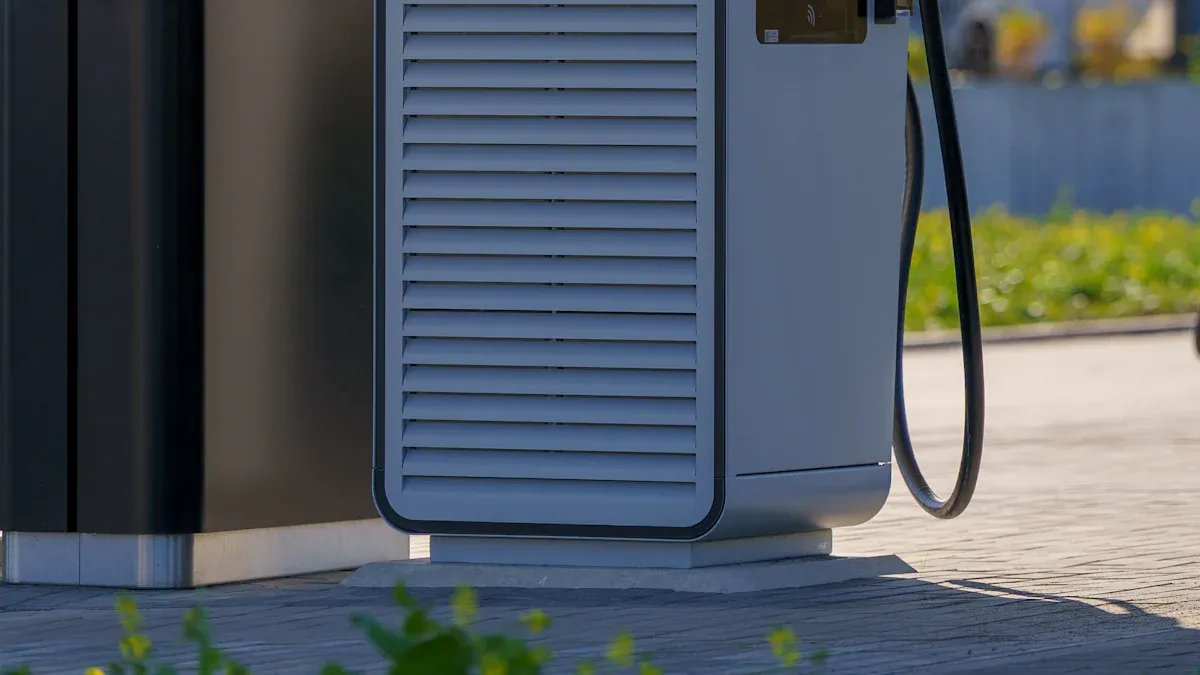
You face intense pressure to deliver non-stop production in your industrial environment. Unplanned downtime can disrupt your workflow and result in significant financial losses.
Unplanned production downtimes can cost 15 times more than planned downtimes.
The estimated cost of robot downtime ranges from $1,000 to $10,000 per minute.
Businesses can lose an average of $260,000 per hour of downtime, which can total over $2 million annually.
Intelligent charging and battery swapping with lithium battery packs now drive non-stop production. These strategies let you keep your robotics fleet running without interruption. Fast charging, autonomous charging, and automated battery swapping eliminate idle time. The table below shows how these solutions deliver measurable benefits:
Benefit | Description |
|---|---|
Quick Replacement | Swappable batteries can be exchanged in about 84.2 seconds, significantly faster than traditional charging. |
Downtime Reduction | Minimizes idle periods by allowing quick battery exchanges, maintaining high productivity. |
Continuous Operation | Enables scheduling of battery swaps during planned breaks, ensuring the fleet remains active. |
Automation | Automated systems maintain 100% uptime, reducing the need for extra robots and optimizing space. |
Cost Efficiency | Reduces total cost of ownership by 32% and boosts operational efficiency by 45%. |
You can achieve non-stop production and cut costs by choosing the right charging strategy for your lithium battery packs.
Key Takeaways
Unplanned downtime can cost businesses significantly, with losses reaching up to $2 million annually. Implementing intelligent charging strategies can help minimize these costs.
Fast charging and battery swapping can reduce idle time for robots, allowing for continuous operation and increased productivity. Consider integrating these systems into your workflow.
Automated battery swapping and self-swapping robots enhance efficiency by eliminating manual intervention. This leads to true 24/7 productivity in industrial environments.
Part 1: Non-Stop Production Challenges
1.1 Downtime Causes
You face many sources of downtime in your industrial operations. Machine breakdowns, equipment failures, and supply chain issues often disrupt your workflow. Robots can stop working due to mechanical drift, misaligned parts, or worn joints. Incorrectly loaded parts and out-of-spec components also contribute to downtime. Human error, labor shortages, and inadequate training further increase the risk. Even unexpected events like cyberattacks or natural disasters can halt production. Each downtime event impacts your productivity and increases costs.
Tip: Regularly review your workflow to identify bottlenecks and address machine performance issues before they lead to downtime.
Battery depletion stands out as a major cause of downtime for robots. When a robot’s battery charge drops below a critical level, it cannot complete its assigned tasks. You must then reassign missions to other robots, which disrupts the workflow and increases downtime. In many cases, multiple missions need reassignment to maintain efficiency. This constant juggling leads to more downtime and reduces overall productivity.
1.2 Battery Limitations
Lithium battery packs power most industrial robots, but they come with limitations. These batteries can overheat, leading to thermal runaway, fires, or explosions. You must follow strict safety protocols when handling and storing them. Lithium-ion batteries also have a limited lifespan. After a few years, their performance drops, making them less suitable for long-term projects.
Proper battery management is essential to minimize downtime. Intelligent battery management systems (BMS) provide real-time diagnostics and fault detection. Features like State of Charge (SOC) and State of Health (SOH) estimation help you adapt to changing workloads. Reliable BMS ensures your robots stay operational and reduces downtime. Choosing the right charging strategies for your lithium battery packs will help you maintain continuous production and avoid unnecessary downtime.
Part 2: Charging Strategies

Industrial robots depend on reliable charging strategies to maintain continuous operation. You can maximize uptime and productivity by selecting the right approach for your lithium battery packs. The following charging methods—fast charging, opportunity charging, and inductive charging—offer unique advantages for different industrial environments.
2.1 Fast Charging
Fast charging has become the backbone of non-stop production in modern factories. You can use high-current DC fast charging systems to recharge lithium battery packs quickly, reducing idle time and keeping your robots on the move. These systems deliver power efficiently and safely, supporting demanding industrial schedules.
Feature | Specification |
|---|---|
Power Conversion Efficiency | 94–96% |
Charging Power Range | 1.5 kW to 10 kW |
Safety Standards | UL 2202, IEC 62368-1, IEC 61851 |
Communication Protocols | CAN Bus, RS-485, Modbus, Ethernet/MQTT |
Thermal Management | Real-time monitoring, automatic shutdown |
Mechanical Design | IP54+ ingress protection, self-aligning docking mechanisms |
You benefit from fast charging in several ways:
Faster, safer charging without sacrificing battery health
Modular power delivery that adapts to workload demand
Predictable thermal behavior under high load
Enables robots to charge themselves without human interaction
Reduces maintenance caused by wear or alignment failure
High-current DC fast charging allows for quicker recharging cycles, which means your robots spend less time idle. Compared to conventional charging, fast charging enables longer operational periods and eliminates the need for extensive downtime. You can speed up the battery charging process, reduce labor, and minimize maintenance. Fast charging uses a higher start rate—often 35% or more—compared to conventional charging at 20%. This difference leads to faster recharging and increased equipment usage.
Tip: Integrate fast charging stations at strategic points in your facility to ensure robots can access power without disrupting workflow.
2.2 Opportunity Charging
Opportunity charging lets you recharge lithium battery packs during short breaks or idle moments. You can take advantage of brief pauses in production, such as shift changes or loading times, to top up your robots’ batteries. This approach keeps your fleet operational and avoids lengthy charging sessions.
Wireless charging systems enhance operational time by allowing robots to recharge while waiting for their next task. In warehouse settings, robots can autonomously recharge during idle moments, minimizing downtime and maximizing efficiency. Opportunity charging ensures that autonomous mobile robots (AMRs) remain deployable at all times, as they recharge during short breaks instead of stopping for long charging cycles.
You can integrate opportunity charging with your production schedule:
Lithium forklift batteries often reach full capacity in under two hours.
Robots recharge during short breaks or shift changes, staying operational longer.
This strategy eliminates the need for lengthy charging sessions or battery swaps, maximizing productivity.
Some manufacturers have reported savings of over $1 million annually by adopting opportunity charging. This method reduces productivity losses associated with battery swaps and long charging downtimes.
Use a fleet management system to monitor charger availability.
Identify which chargers are used most frequently and optimize their placement.
Maximize robot uptime through effective opportunity charging.
2.3 Inductive Charging
Inductive charging offers a cable-free solution for continuous production environments. You can eliminate the need for physical connectors, reducing handling time and mechanical wear. Inductive charging improves safety in areas with moisture, dust, or chemicals because there are no exposed connections.
Simplicity: No cables, less handling time, and reduced connector wear
Improved safety: Lower risk in harsh environments
Seamless integration: Automatic recharging without human intervention
Cleaner designs: Less clutter and longer equipment life
Inductive charging systems typically achieve efficiencies between 70% and 90%, while traditional plug-in charging methods can exceed 95%. You must ensure precise alignment for optimal performance, as misalignment can hinder operational effectiveness. Despite this limitation, inductive charging remains a strong choice for environments where safety and automation matter most.
Note: Inductive charging works well in medical, robotics, and security system applications, where reliability and safety are critical. For industrial robots, you can combine inductive charging with opportunity charging to further boost uptime.
By selecting the right charging strategy for your lithium battery packs, you ensure your robots stay productive and your operations remain efficient. Each method—fast charging, opportunity charging, and inductive charging—offers unique benefits for different industrial scenarios.
Part 3: Battery Swapping

Industrial operations demand uninterrupted performance from your robotics fleet. You can achieve this by implementing advanced battery swapping strategies. These approaches allow you to maintain continuous production, minimize downtime, and optimize the use of lithium battery packs. Let’s explore how automated swapping, self-swapping robots, and swap dock design can transform your workflow.
3.1 Automated Swapping
Automated swapping systems have become essential in high-volume industrial environments. You can deploy these systems to replace depleted lithium battery packs with fully charged ones in seconds, eliminating the need for manual intervention. Automated swapping stations use robotics and advanced sensors to handle batteries safely and efficiently.
Battery Chemistry | Typical Charging Time | Impact on Productivity |
|---|---|---|
Lithium-ion | 1–2 hours | Reduces idle time |
LiFePO4 | 1 hour | Increases operational efficiency |
You benefit from automated swapping in several ways:
Quick battery replacement minimizes downtime and keeps your robots active.
Scheduled swapping ensures continuous operation, even during peak production.
Flexible charging infrastructure adapts to your facility’s unique needs.
Tip: Automated battery swapping [internal link: /battery-swapping] solutions can reduce your reliance on spare robots and optimize floor space. You can schedule swaps during planned breaks or low-demand periods to maximize productivity.
The global market for robot battery swapping stations is expanding rapidly. Industry analysts project growth from USD 752.4 million in 2024 to over USD 5.1 billion by 2033, with a CAGR of 27.1%. This surge reflects the increasing demand for uninterrupted operations in manufacturing, logistics, and other industrial sectors. You can stay ahead by adopting automated swapping systems that support your uptime goals.
3.2 Self-Swapping Robots
Self-swapping robots represent the next evolution in autonomous operations. These robots can manage their own battery changes without human assistance. You gain the advantage of true 24/7 productivity, as robots independently monitor their battery status and initiate swapping when needed.
Consider the Walker S2 robot as an example. It features a dual battery system with two 48-volt lithium-ion packs. The robot can:
Pull out and replace its own batteries, ensuring self-sufficiency.
Return autonomously to a charging station when one battery is low, after about two hours of walking or four hours of idling.
Complete a battery swap in less than three minutes, using a secondary backup battery to maintain power during the process.
Use onboard energy management software to optimize charging and swapping cycles.
A demonstration video shows the Walker S2 navigating to its docking station, ejecting the depleted battery, and retrieving a fresh one—all without human intervention. This seamless process highlights the potential for self-swapping robots in factories, warehouses, and logistics centers.
Note: Self-swapping robots can operate in diverse environments, including medical, security, and infrastructure sectors. You can deploy them in hazardous or remote locations where manual battery changes are impractical.
3.3 Swap Dock Design
The design of your swap docks plays a critical role in the efficiency and safety of battery swapping operations. You must choose between automated and manual systems based on your operational scale, labor availability, and the need to minimize downtime. Automated docks are ideal for high-volume facilities, as they reduce human labor and speed up the swapping process.
Key design considerations include:
Integration of advanced sensors and robotics for precise battery handling.
Real-time monitoring and thermal management systems to ensure safety.
Modular layouts that support different lithium battery chemistries and pack sizes.
Dock Type | Efficiency Features | Safety Features |
|---|---|---|
Automated Docks | Hands-free battery replacement, advanced sensors, robotics | Thermal management, real-time monitoring |
Manual Docks | Ease of use, human assistance | Safeguards to prevent mishandling |
Automated swap docks use robotics to handle batteries quickly and safely. You can rely on these systems to maintain uptime in sectors where continuous operation is critical. Manual docks may suit smaller operations, but they require trained staff and introduce the risk of human error.
Callout: Always match your swap dock design to your facility’s production volume and safety requirements. Automated systems offer the best performance for large-scale industrial applications.
By investing in advanced battery swapping strategies, you ensure your robots remain productive and your operations stay competitive. You can leverage the latest technologies in lithium battery packs, robotics, and automation to achieve true non-stop production.
Part 4: Multi-Robot Coordination
4.1 Parallel Task Execution
You can maximize production throughput by coordinating multiple robots to execute tasks in parallel. Modern industrial environments rely on advanced control systems and battery management systems to schedule and allocate resources efficiently. These systems ensure that robots equipped with lithium battery packs can handle several tasks at once, reducing downtime and boosting operational efficiency. You benefit from streamlined operations, as robots prioritize critical assignments and manage less urgent jobs in the background.
Best Practice | Description |
|---|---|
Effective Bot Management | Enables robots to handle multiple tasks simultaneously, preventing overload. |
Advanced Scheduling Systems | Optimizes resource use and adapts in real time to production demands. |
Task Prioritization | Ensures critical tasks receive immediate attention through smart allocation. |
When you deploy robots with different lithium battery chemistries—such as LiFePO4 or NMC—you gain flexibility in specialized tasks. Buffer management between robots helps maintain a steady flow of parts, while adaptable scheduling allows you to respond to changing production needs. This approach leads to enhanced efficiency, reduced operational costs, and improved resource management.
Enhanced efficiency through reduced downtime
Lower operational costs by optimizing resource use
Improved resource management with smart allocation
4.2 Coordinated Charging and Swapping
Coordinating charging and swapping among your robot fleet is essential for maintaining high operational efficiency. You can use allocation methods and availability rules to optimize the number of robots and reduce traffic at charging stations. By monitoring key performance indicators—such as task delays, average state of charge, and charging station utilization—you ensure that robots with lithium battery packs remain active and productive.
Strategy Type | Description |
|---|---|
Allocation Methods | Optimize the number of robots, reducing congestion and improving performance. |
Availability Rules | Enhance operational efficiency by ensuring robots access charging or swapping as needed. |
Key Performance Indicators | Track metrics like task delays and average state of charge to evaluate strategy success. |
Dynamic path planning lets robots adjust their movements based on real-time awareness of their teammates’ positions. This coordination prevents bottlenecks and ensures that robots can access charging or swapping stations without delay. You also benefit from redundancy, which maintains system functionality even if a robot or station fails.
Tip: Coordinated charging and swapping strategies reduce downtime, improve fleet utilization, and support business sustainability by making energy use more efficient.
By integrating advanced battery management systems and leveraging the strengths of lithium battery chemistries, you can achieve continuous, non-stop production in sectors such as medical, robotics, security systems, infrastructure, and industrial manufacturing.
Part 5: Battery Management
5.1 Health Monitoring
You need robust health monitoring to keep your lithium battery packs reliable during continuous operation. Modern battery management systems (BMS) use advanced communication protocols and balancing techniques to deliver real-time data on voltage, current, and temperature. This information helps you prevent thermal runaway and overcharging, which are critical for safety in industrial, medical, and robotics applications.
Real-time monitoring with IoT technology and Grafana software gives you instant access to battery metrics.
The Dynamic Z-Track algorithm estimates state of charge (SOC) and state of health (SOH) with high accuracy, even as loads change rapidly.
Health monitoring systems alert you to reduced capacity or irregular battery charging, so you can act before failures occur.
Effective health monitoring prevents unexpected power loss and keeps your robots ready for continuous operation. You can rely on these systems to support your charging infrastructure and maintain high productivity.
5.2 Predictive Maintenance
Predictive maintenance uses data analytics, machine learning, and sensor technology to optimize your battery charging and maintenance schedules. This approach reduces unexpected breakdowns and extends the lifespan of your lithium battery packs, supporting continuous operation in sectors like security systems and infrastructure.
Technique | Description |
|---|---|
Data Analytics | Uses real-time data to monitor battery health and predict maintenance needs. |
Machine Learning | Analyzes historical data to forecast potential battery failures. |
Sensor Technology | Tracks performance metrics such as temperature and voltage. |
A hybrid machine learning framework, such as Improved Random Forest (IRF), delivers high accuracy in anomaly detection and health diagnostics. You benefit from proactive interventions, reduced operational risks, and longer battery life. Using sensors to measure vibration, temperature, and sound, you receive alerts about irregularities, allowing you to schedule maintenance before issues disrupt your charging solutions.
Predictive maintenance increases operational efficiency and improves customer satisfaction.
You can trust these systems to keep your charging infrastructure running smoothly and support non-stop production.
You can achieve reliable performance by adopting advanced lithium battery charging and swapping strategies.
Smart maintenance and modular battery designs streamline the robot charging process.
AI-driven management systems reduce downtime and boost efficiency.
Over the next five years, expect higher energy density batteries and smarter automation.
Request a custom battery consultation to optimize your operations.
FAQ
What is the best strategy to maximize robot uptime in industrial environments?
You should combine fast charging, swappable batteries, and coordinated charging stations. This strategy ensures high uptime and reliable performance for robots.
How do swappable batteries improve automation and battery efficiency for autonomous mobile robots?
Swappable batteries let autonomous mobile robots quickly exchange depleted packs at charging stations. This automation boosts battery efficiency, reduces downtime, and supports continuous performance in medical and security system applications.
Why should you choose Large Power for lithium battery optimization and performance?
Large Power delivers advanced lithium battery packs, swappable batteries, and charging stations. You gain expert consultation and proven optimization strategies. Request a custom consultation for tailored battery solutions.






